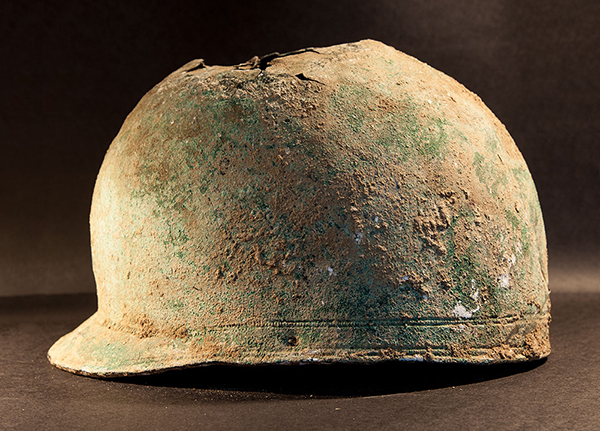The Department of Classical and Archaeological Studies has helped confirm that a helmet unearthed in Kent dates back to the 1st century BC.
The helmet, found in farmland near Canterbury in September, is made of bronze and was discovered alongside a brooch by an amateur metal detectorist. Working with Canterbury Archaeological Trust, the helmet has been carefully scanned by archaeologists at Kent using state-of-the-art technology to help define the history of the object. Using a contactless scanner, with a resolution better than 0.08mm, the team have been able to see small hammer indentations in the helmet. The scanner also produces digital pictures helping to reveal intricate details often hidden by colour variations on the helmet’s surface.
Dr Steven Willis, Senior Lecturer in Archaeology and an expert in Iron Age and Roman Britain, said of the find: ‘We are delighted to be able to assist with such a remarkable find for Canterbury and the local area. Using laser-scanning technology, which has become an essential part of the conservation of objects, we have been able to analyse the helmet from a distance and unlock many details of such an exciting find, such as the manufacture, decoration and use.
‘This sort of emerging technology allows the rapid production of accurate and high-resolution digital 3D models of archaeological artefacts, minimising the potential harm associated with the repeated handling of these often fragile objects. The technology also ensures any details potentially overlooked by the naked eye are also highlighted.
‘The secrets of this helmet are only just beginning to emerge but we will know much more as the work progresses. More or less intact helmets of this era are very rare finds, one used as a cremation container, as with this example, is known from Belgium’, Dr Willis added.
Due to the discovery’s archaeological significance, which includes two prehistoric metal objects found together, the find has been registered under the Treasure Act (1996). The objects have been reported to the Coroner and will remain at the British Museum where a special report will be prepared.
Julia Farley, Iron Age curator at the British Museum said: ‘This is a very exciting find, one of only a handful of Iron Age helmets to have been found in Britain. In Late Iron Age Kent, it was not unusual to bury the cremated remains of the dead in a bag fastened with one or more brooches, but no other cremation has ever been found accompanied by a helmet. The owner of this helmet, or the people who placed it in the grave, may have lived through the very beginning of the story of Roman Britain.’
It is hoped that Canterbury Museum will be able to acquire the finds so they can be permanently displayed in Kent. The person who found the treasure has wished to remain anonymous.
Further to the news announcement of our involvement in the identification of an Iron Age helmet, the School of European Culture and Languages has featured on a number of news items, including BBC and ITV, regarding the discovery.

